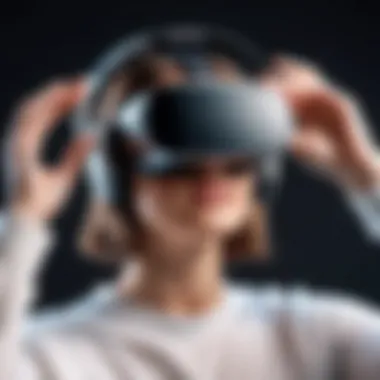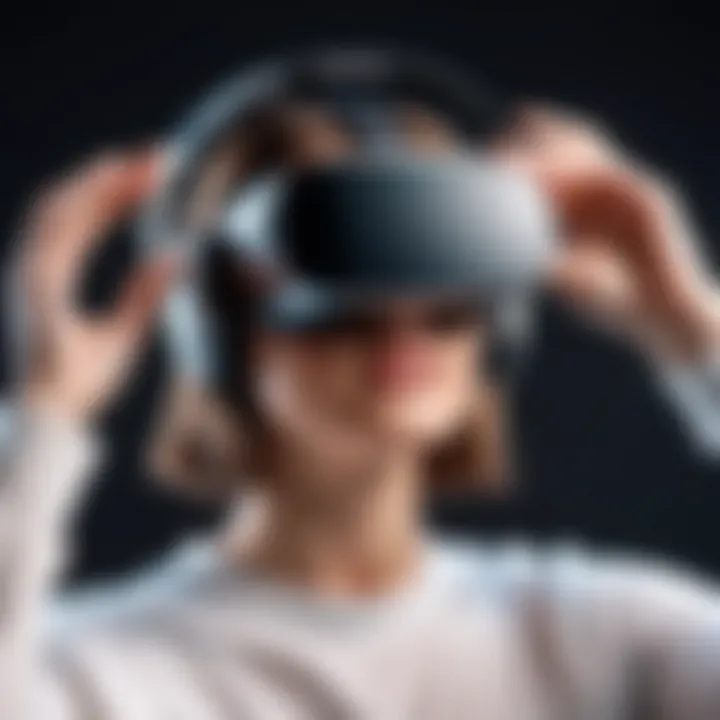Visualizing Your Future Self: Techniques and Insights


Intro
The journey of self-exploration often intertwines with technology, particularly in how we envision our future selves. As we stand on the brink of emerging innovations, it becomes crucial to grasp how tools and methodologies can reshape our perception of aging and personal identity. In this discussion, we unravel the threads of technology and psychology, connecting them to personal transformation. This exploration not only addresses the practical aspects of visualizing our future, but also prompts profound reflections on who we are becoming.
Technology Insights
Latest Tech Trends
Technology has become a crucial element in shaping our self-perceptions and our views on aging. There are tools, apps, and even advanced imaging technologies that allow us to see ourselves as we might appear many years down the road. For instance, similar to the wild success of popular age-progression apps, innovative software programs are harnessing artificial intelligence in ways that can present realistic projections of an individual's future look.
Some noteworthy examples include:
- FaceApp: Known primarily for its ability to apply filters, this app also offers an age progression feature that gives users a glimpse into their potential future selves.
- AgingBooth: While a bit more simplistic, this user-friendly app lets folks see how they might age in a playful manner.
These applications tap into a deep-seated curiosity about the passage of time, prompting us to reflect on our lives and potential transformations.
Innovation in Tech
Recent advancements extend beyond mere visualization. Virtual reality and augmented reality have surfaced as game-changers. They provide fully immersive experiences that not only allow individuals to see aging effects but also to interact within simulated future scenarios. For example, developers are creating platforms where you can experience your life 10, 20, or even 30 years from now.
Additionally, technologies like mindfulness apps are helping folks reflect on where they are in life and how they wish to evolve. Many emphasize the importance of mental well-being as a significant factor in how we perceive aging. The marriage of technology with self-reflection can pave the way for more conscious living and a better approach to future ambitions.
Product Reviews
While tech tools are indispensable, selecting the right one can be daunting. Here’s a quick look at some noteworthy products:
- Lifelogger: This camera-recording technology tracks daily activities. It might not provide a direct look into the future, but it shapes how one reflects on personal growth over time.
- MyLifeApp: Aimed at helping individuals set goals and visualize their paths ahead, this app can be pivotal in personal transformation journeys.
- FutureMe: While not as tech-heavy, it allows users to send future emails to themselves, establishing a direct line to their future thoughts and goals.
The selection of these products showcases how diverse this area is and how thoughtfully integrating technology into self-perception can yield beneficial outcomes.
"The fusion of technology and self-exploration offers an unparalleled avenue for individuals to analyze their personal growth and aspirations."
As we delve deeper into this exploration of our future selves, the interplay of technology, psychology, and self-reflection will be instrumental in examining potential evolution. Each tool mentioned above serves as a stepping stone on this intriguing journey, leading to introspection and eventual transformation.
Preamble
In today's rapidly changing world, the pursuit of understanding one's future self isn't just a philosophical musing; it's becoming an essential part of personal development. This article aims to bring clarity to how individuals can visualize their future selves through a blend of technology and introspection.
The significance of this discussion lies in the awareness it cultivates about the aging process and personal transformation. Visualizing the future can be a powerful motivator, pushing individuals toward healthier lifestyles, better decision-making, and ultimately leading to increased satisfaction and fulfillment in life. When we see ourselves in a future light, it can shape our current behaviors and fuel our ambitions.
Consider the psychological implications—when people can engage with their elder selves, they often confront issues of vulnerability, wisdom, and legacy. It is sort of a wake-up call to the present, urging individuals to align their current actions with long-term aspirations.
Here are a few key benefits that the exploration of our future selves can offer:
- Informed Decision Making: Planning for the future often requires tough choices in the present. Visualizing your future self can simplify those choices by providing clarity on what truly matters to you.
- Enhanced Motivation: Having a clear picture of the future can spark excitement and energy in pursuing personal goals. When you can see an older, wiser version of yourself thriving, it’s easier to stay committed to your current path.
- Improved Mental Health: Engaging in future self-reflection may lead to reduced anxiety surrounding aging, as it allows individuals to embrace the changes that come with time rather than fear them.
- Strengthened Identity: Our future self can act as a guiding star that shapes our sense of self. This can help clarify our values and priorities, leading to a more cohesive identity over time.
Ultimately, understanding how to visualize our future selves provides a practical framework rooted in psychology and technology. This sets the stage for deeper dives into specific methodologies and tools that can aid in this fascinating exploration.
The Concept of Future Self
In the realm of personal development, the concept of the future self serves as a powerful framework for individuals seeking to align their present actions with future aspirations. This notion transcends mere wishful thinking—it's a cognitive tool that empowers people to visualize their desired future, compelling them to consider who they want to become over time. The benefits of engaging with one's future self are manifold; they range from enhanced motivation and goal clarity to improved mental resilience.
The importance of this topic lies in its potential to change an individual’s trajectory. Rather than living day-to-day without direction, contemplating the future self encourages one to take stock of their values, ambitions, and goals. This self-reflection fosters a sense of accountability and proactivity, nudging individuals towards making choices that cultivate long-term success and fulfillment. It invites us to examine the fine line between who we are and who we hope to become.


Understanding Future Self-Perception
Future self-perception is much like looking into a mirror set in the future. This perception isn’t merely about altering one’s appearance with the passing years; it also encapsulates internal developments, habits, and lifestyles one envisions having. Psychological research indicates that those who actively engage in future self-perception are often more invested in their personal growth. They can bridge the gap between the present and future selves, creating a continuous thread of identity that aligns with their aspirations.
Engaging with future self-perception can feel like more than just an exercise in imagination; it's a compelling motivator. Individuals who visualize a strong future self are likelier to pursue healthier behaviors, save money, and make decisions that benefit their long-term growth. Having a concrete image of their aged self can drive them to adopt values and habits that resonate with that vision, fostering continuity in their identity.
Psychological Impacts of Visualizing Aging
Visualizing aging can be a double-edged sword. On one hand, this practice offers the opportunity for profound self-reflection and transformation. When individuals visualize themselves growing older, it can lead to a clearer understanding of their life's trajectory. In contrast, seeing oneself in a negative light—perhaps struggling or dissatisfied in old age—can provoke anxiety or avoidance behavior. Thus, the psychological impacts of this form of visualization are substantial.
Research suggests that those who maintain a positive mental image of their future are better prepared for aging. They find it easier to confront the inevitable changes that will occur with time. > "Imagining your future self can significantly influence how you lead your life in the present," says Dr. Emma Hart, a psychologist specializing in self-perception. Ultimately, a positive view encourages healthier life decisions, while a negative perspective might promote harmful shortcuts or reticent behaviors that detract from long-term wellness.
Philosophical Considerations on Identity
The philosophical angle concerning identity delves deeply into who we perceive ourselves to be across time. It raises questions around continuity and change; how can we remain fundamentally the same while undergoing significant changes? The dialogue surrounding identity creates a rich tapestry of thought, especially when discussing the future self.
One essential aspect is the idea of future continuity. Some philosophers argue that maintaining a connection with our future selves is crucial for understanding personal identity. This viewpoint posits that the choices made today resonate across time, shaping the character of tomorrow. Hence, when considering our future selves, we should also reflect on the actions and decisions we make presently, as these will undoubtedly carve our path.
Technological Tools for Visualization
The ability to envision one’s future self is a fascinating blend of psychology and technology. With advancements in tools available today, individuals can engage with their projections in ways previously thought infeasible. The intersection of technology and self-perception opens new doors for understanding aging and identity. This section aims to unpack the various technologies that enable self-visualization, exploring their benefits, limitations, and overarching significance in our daily lives.
Age Progression Software Overview
Age progression software has evolved into a remarkable tool for those eager to glimpse their future. These programs utilize complex algorithms to create renderings of what individuals might look like as they age. Think of it as a sophisticated camera lens, distorting time in a way that reveals more than just a reflection. Popular examples like FaceApp and AgingBooth have gained popularity not just for their entertainment value but for helping people confront the aging process.
Using these programs is quite straightforward. Users upload their photos, and the software does the rest, generating various projections based on age models.
Benefits of Age Progression Software:
- Personalize Future Perspectives: By visualizing their older selves, users can better understand the implications of their life choices today.
- Catalyst for Change: This realization can inspire changes in lifestyle, health, or behavior.
- Fostering Acceptance: Seeing a realistic portrayal of aging can help alleviate the fear commonly associated with getting older.
While the technology is engaging, users should consider the realism of generated images. These tools can serve as a launching pad for deeper discussions about identity and transformation.
Virtual Reality and Future Self Scenarios
Virtual reality (VR) stretches the boundaries of what is perceived possible. By immersing oneself in a virtual world, a person can interact with Avatars of their future selves, shaping experiences that are both profound and enlightening. VR platforms create dynamic environments where users can experiment with various scenarios that showcase their potential lives. This interaction goes beyond mere observation and taps into experiential learning—an effective way to draw conclusions about preferences, fears, and aspirations.
Highlights of VR Visualization:
- Immersive Experience: Users can walk through their possible future environments, experiencing their lives with all senses engaged.
- Real-time Decision Making: It allows for active participation in hypothetical events, promoting reflection on actual life choices.
- Emotional Connection: Engaging directly with a representation of oneself seems to evoke stronger emotional responses than still images.
Incorporating VR is pivotal for tech-savvy individuals who seek not only to visualize but to experience potential futures in a compelling manner.
The Role of Artificial Intelligence
Artificial intelligence (AI) plays a transformative role in shaping how future selves are perceived. Through machine learning and data analysis, AI algorithms can personalize experiences based on user preferences, behavior, and aspirations. Imagine AI technology that tailors simulations of your aging process, taking into account not just physical characteristics but also lifestyle choices and health data. This adds layers of personalization previously unattainable.
Key Aspects of AI in Visualization:
- Personalized Projections: AI adjusts visualizations according to genetic predispositions or health impacts based on data inputs.
- Predictive Modeling: By analyzing trends and lifestyle choices, AI can offer scenarios of potential futures that feel more grounded in reality.
- Facilitating Emotional Insights: Through deep learning, AI can assess existing emotional responses to different scenarios, guiding users toward greater self-awareness.
"Technology does not only help us envision the future; it allows us to understand it in ways that are deeply personal and transformative."
Practical Approaches to Visualization


In the journey toward understanding and envisioning our future selves, practical approaches to visualization serve as potent tools. They enable us to step back from our everyday lives and analyze where we might be heading. These methods not only foster creativity but also help in personal growth by creating a visual representation of future possibilities. Exploring these approaches can enhance one's self-awareness, ultimately leading to informed choices surrounding health, career, and relationships.
Many times, individuals feel a disconnect between their current selves and the future persona they desire. This section outlines three specific techniques that empower individuals to create vivid images of their future selves.
Creating Future Scenarios through Artistic Representations
Artistry, in its various forms, can be an introspective exercise. Engaging in artistic representations to create future scenarios allows a person to express their hopes and fears connected to aging. Whether it’s painting, drawing, or digital art, the process of creation provides a space for exploration. For example, consider utilizing a canvas or sketching pad to outline how you envision your life ten years from now. Incorporating elements from your desires, such as travel, career achievements, or personal relationships, creates a storyboard of sorts. This approach encourages individuals to think beyond surface-level aspirations and dig into the emotional landscape of their future.
Moreover, using mixed media can deepen this experience. Collage-making allows you to piece together images, words, and even textures that resonate with your future vision. This tangibility can foster a stronger emotional connection to your aspirations. Not only does it spark imagination, but it also cultivates a sense of ownership over the dreams laid out on the canvas of your life.
Utilizing Photo Manipulation Techniques
The advent of photo manipulation software has opened fascinating doors for visualizing the future. Using tools like Adobe Photoshop or online platforms such as Pixlr, individuals can manipulate images to see aging effects or changes in lifestyle. For instance, you might start with a current picture and apply filters that simulate aging. This practical visualization helps bridge the gap between imagination and reality.
Keep in mind the importance of balance when utilizing these techniques. While the output is often striking, it's crucial not to become entangled in unrealistic expectations or artistic fantasies that stray too far from genuine self-reflection. Instead, view manipulated images as prompts for deeper thought—how do they reflect your values or desires? This reflective practice can lead to new insights regarding personal choices and priorities.
Engaging with Avatar Creation Tools
In today's digital age, creating avatars has become commonplace in gaming, social media, and more. But did you know these tools can serve well beyond mere entertainment? Engaging with avatar creation tools like Bitmoji or Zmoji provides a playful entry point into the visual representation of future self. Customizing an avatar can be much more than dressing a digital figure; it serves as a reflection of who you aspire to be.
By selecting different attributes—such as clothing styles, career roles, and settings—you are essentially drafting a narrative of your future identity. This process can illuminate gaps between where you are now and where you want to be. Additionally, sharing your avatar within your social circles can open discussions around individual growth and aspirations, creating an avenue for peer support.
"One's future self is a reflection of the choices made today; engage thoughtfully in the contemplation of who you truly wish to become."
In summary, practical approaches to visualization invite a dynamic exploration of both the current self and the future self. Through artistic creation, photo manipulation, and avatar customization, individuals can construct a multifaceted outlook on aging and identity that resonates on various levels, making the journey toward self-discovery both insightful and empowering.
Limitations of Current Methods
The journey into the realm of future self visualization carries a wealth of promise, but it doesn’t come without its potholes. Recognizing these limitations is crucial as they not only dictate the accuracy of our perceptions but also our emotional responses towards aging and self-identity. By understanding these constraints, we can better navigate the tools available to us.
Ethical Concerns of Future Visualization
The ethical landscape surrounding future visualization is complex. When we engage with methods aimed at perceiving our future selves, we step into a grey area occupied by questions of morality and consent. For instance, should age progression technologies be used on individuals without their explicit consent? An example comes to mind where companies use digital simulations from social media data. While this might enhance the user experience, it raises concerns about privacy and manipulation.
Moreover, there’s a concern about how people perceive these visualizations. If someone sees a future self ravaged by illness, could that result in anxiety or despair? The psychological impacts could be profound. It’s like looking into a mirror that shows not just age, but also a future that might influence life decisions in ways we can’t foresee. Understanding these moral quandaries is essential as society moves further into technological innovation.
Technological Limitations and Realism
While tech has made giant leaps, it still has its limitations when simulating the future. Advanced algorithms are great, but they often rely on existing data and trends, which means they may not accurately predict unforeseen changes in lifestyle or environment. For example, a person might envision themselves as physically fit at fifty but fail to incorporate lifestyle changes such as moving to a different climate or suffering significant life events that could impact health.
Realism is another major issue. The more realistic a visualization tool is, the more it holds potential for positive or negative psychological effects. Yet, overestimating its accuracy can lead to disappointment. For example, if a user expects a perfect image of their future self, only to receive something less flattering, it may distort their self-image further. This brings back the question of balance; striking a balance between innovation and realistic portrayals is essential.
Cognitive Biases Impacting Self-Perception
Lastly, our cognitive biases play a critical role in influencing how we perceive our future selves. Psychological phenomena such as optimism bias can lead individuals to assume they will age more gracefully than they might. This unrealistic expectation can skew a person's view of aging—like wearing rose-colored glasses that shield one from reality.
Consider the Dunning-Kruger effect, where some may overestimate their ability to manipulate their circumstances based on visualizations. They might think, "If I can visualize this ideal future, I can definitely achieve it!" However, the gap between perception and reality is often wider than we realize. Understanding these cognitive biases can help individuals take their visualizations and experiences with a grain of salt—acknowledging potentials while recognizing limitations.
Being aware of the ethical, technological, and cognitive limitations in visualization not only establishes clearer expectations but also helps individuals cultivate a healthier relationship with their future self.
By connecting these ideas, we see that while the tools for visualizing the future can be compelling, they must be approached with caution. Any attempt to peer into the future needs an understanding of these limitations to avoid disillusionment.
Cultural Reflections on Aging


Understanding cultural reflections on aging is key in widening our perspectives on how we view our future selves. Our perceptions of age are often shaped by the cultural narratives that surround us. These narratives influence how we think about growing older, what we aspire to, and how we envision our lives in later years. In this context, the importance of cultural reflections lies in their ability to provide a lens through which we can examine both individual and collective identities over time. They guide us not just in enacting social norms, but also shape our internalized beliefs about aging.
Global Perspectives on Aging
Aging is a universal experience, yet the way it is perceived varies widely across different cultures. For instance, in some Asian cultures, elders are revered for their wisdom and contributions, while in many Western contexts, there is a tendency to associate aging with decline and loss of vitality. This divergence can affect how individuals visualize their future selves, altering not only aspirations but also behaviors regarding health and lifestyle choices. In regions like Scandinavia, policies tend to support aging populations through active community engagement, whereas in less developed nations, resources may be scarce, leading to diminished respect for the elderly. Thus, globally, perceptions surrounding aging influence everything from public policy to personal attitudes.
Media Influence on Aging Perception
The media plays a crucial role in shaping public perceptions of aging. From movies to social media platforms, the representation of older individuals can either challenge stereotypes or reinforce damaging narratives. Notably, the glorification of youth often overshadows the value of aging, leading many to aspire to unattainable ideals of beauty and vitality. The online space, especially, is filled with curated images that may distort natural aging processes, pushing individuals to avoid confronting the reality of their future selves. This becomes a double-edged sword: while it may inspire some to maintain healthy habits, it also fosters unrealistic expectations and anxiety around aging.
"Media creates an image of aging that can often be more fiction than reality, leading to the struggles individuals face in accepting their future."
Cultural Narratives of the Elderly
Cultural narratives around the elderly tell stories of resilience, wisdom, and sometimes, marginalization. In many cultures, storytelling traditions serve as a means to pass down wisdom from the old to the young, embodying the very essence of what it means to age gracefully. These narratives can empower individuals to take pride in their years, learning from past experiences while inspiring their peers. Conversely, they can also perpetuate negative stereotypes, painting a picture of the elderly as frail and out of touch. It's essential to dissect how these narratives are formed and disseminated, as they affect not only individual self-perception but also societal attitudes towards aging as a whole.
In the end, cultural reflections on aging are not just about the past or the present; they shape how we visualize our future selves and, importantly, how we relate to those who have walked the path before us.
Future Trends in Visualization
The landscape of future self-visualization is evolving at a remarkable pace, driven by technological advancements and innovative methodologies. This section emphasizes the significance of keeping an eye on emerging trends, which can have profound implications for how we perceive and envisage our aging selves. By understanding these trends, we gain insights into how they can influence self-perception, motivate personal growth, and enhance overall well-being. As we navigate the complexities of aging, the integration of technology in our lives opens new avenues for self-exploration and understanding.
Advancements in Medical Imaging Technologies
Medical imaging technologies are not just for diagnosing health issues; they are becoming integral to the visualization of the aging process. Techniques such as MRI and CT scans have advanced significantly, allowing us to view anatomical changes over time with unparalleled clarity. For instance, researchers are now able to track age-related changes in the brain, offering not only insights into neurological health but also how those changes influence personality, decision-making, and self-identity.
Moreover, these advancements can support a deeper comprehension of how lifestyle choices affect our long-term health. By visualizing our current condition alongside projected changes, individuals may become more motivated to make healthier decisions. Imagine a time when a simple scan can illustrate a future landscape of both frailty and vitality, guiding users toward better habits.
The Rise of Biometric Data in Future Projections
Biometric data, which includes fingerprints, facial recognition metrics, and voice patterns, is gaining traction as a means to project our future selves. Companies like Apple and Google are already harnessing this data to create personalized experiences. Such information can help create tailored digital representations of ourselves as we age. For example, using facial recognition AI, we might easily generate realistic images of how we will look decades down the line based on our current biometric data combined with aging algorithms.
This rise of personalized data not only enhances the accuracy of future self-visualization but also fosters a sense of personal accountability. Knowing that our choices today can lead to specific future outcomes becomes not just a possibility but a tangible reality.
Potential Influence of Augmented Reality
Augmented Reality (AR) stands on the precipice of transforming how we visualize our future selves. With AR, users can overlay virtual images onto their real-world environment, creating a bridge between the present and the future. Imagine donning AR goggles that project your future self in real-time as you go about your daily activities. This can help in grounding the abstract concept of aging into concrete, visual experiences.
As AR technology continues to improve, the potential for practical applications grows. For instance, imagine using AR to visualize the effects of stress or alcohol consumption on your aging process right before your eyes. Such tools could prove invaluable for both single individuals and health professionals trying to design personalized aging plans.
"Visualization technologies are no longer a novelty; they are becoming essential tools for self-reflection and personal development."
In summary, the trends in future visualization are shaping not only how we imagine ourselves as older adults but also the choices we make in our daily lives. Advancements in medical imaging, the rise of biometric data, and the potential of augmented reality all converge to create a more dynamic understanding of aging. As these technologies develop, they offer a promising outlook on how we can embrace our future identities.
Culmination
As we wrap up our exploration into the fascinating concept of perceiving our future selves, it's crucial to reflect on the overarching importance of this topic. The ability to visualize what we might become is not merely an exercise in curiosity; it is a powerful tool that shapes our decision-making processes and personal growth.
Visualizing our future self influences how we approach our lives today. It pushes us to consider the long-term consequences of our actions, which can serve as a profound motivator for change. For instance, understanding the potential aging process can lead us to adopt healthier lifestyles and make smarter choices regarding our mental well-being. This awareness is not just about avoiding pitfalls, but actively pursuing a future that aligns with our values and aspirations.
Moreover, this journey into self-perception fosters deeper reflections on identity. It challenges us to ponder who we are in relation to who we want to be. Such contemplation often brings to light discrepancies between our current path and our desired future, stirring the motivation for transformation. In a world increasingly influenced by technology, the tools we use to visualize ourselves, whether age progression software or other advanced techniques, can bridge the gap between reality and our imagined futures.
Understanding different methodologies and their implications allows us to harness technology to our advantage. Here’s what you might consider:
- Ethical Considerations: Always keep in mind the ethical implications of visualizing your future self. Things like privacy and data usage can raise important questions.
- Realistic Expectations: While technology can provide eye-opening insights, it is vital to maintain realistic expectations. Our future is not set in stone.
- Potential for Growth: This process opens doors to growth that one might not even foresee. It invites us to continually evolve rather than remain static in our identity.
In summation, visioning our future selves is a blend of science, philosophy, and personal introspection. The relevance of this practice extends beyond mere curiosity—it touches on elements of hope, ambition, and the timeless quest for meaning in our lives. While we may not fully control our futures, embracing this explorative journey empowers us to steer our paths toward the existence we desire.
"The most important thing about your future is that it's in your hands." - Unknown
As we step back and reflect on this topic, let us remember that our future selves are always within our reach, shaped by the choices we make today.







